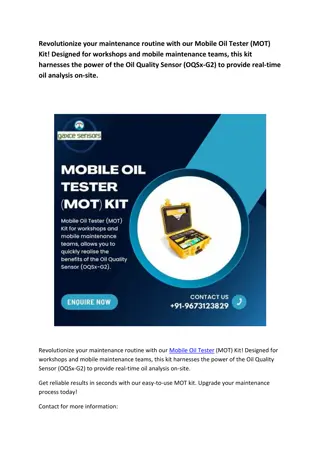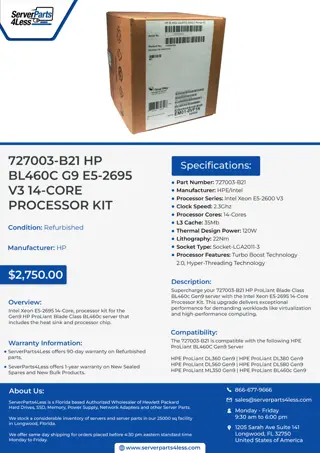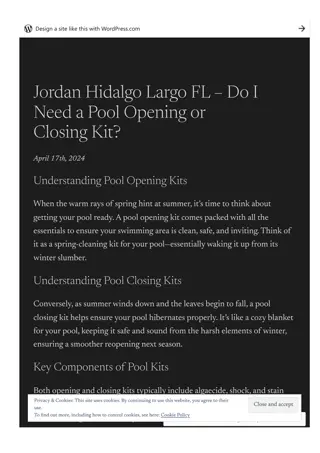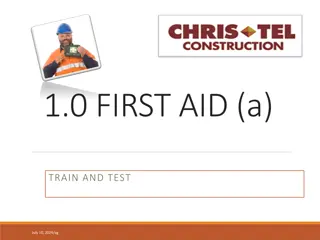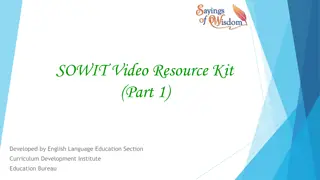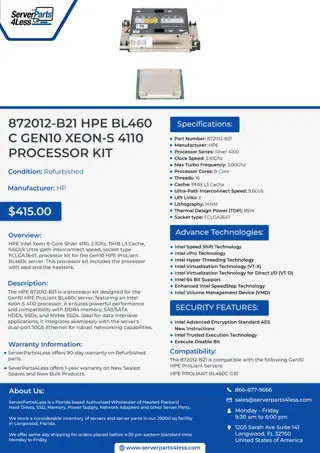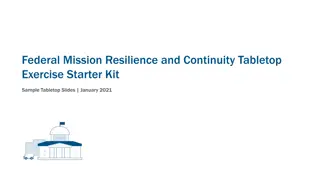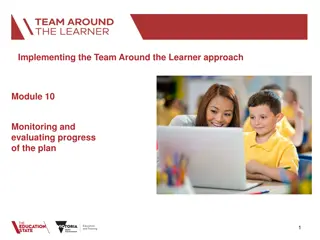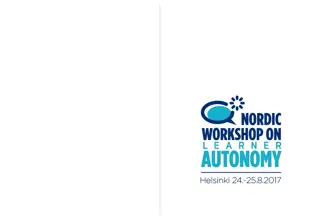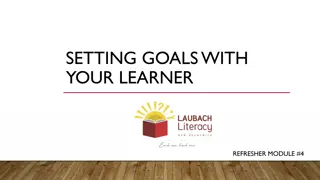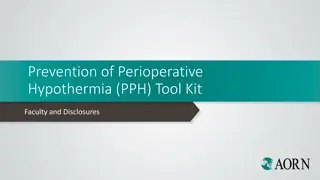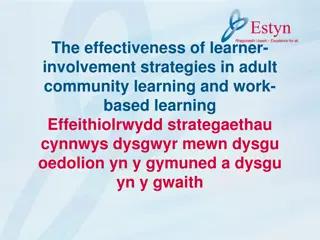English Learner Tool Kit - Language Assistance Programs
This module focuses on Language Assistance Programs for English learners, discussing legal obligations, enhancing practices, and meeting the needs of EL students, parents, and families. It covers essential topics such as identifying ELs, staffing, meaningful access, inclusive environments, communication with parents, and significant legal history including Title VI, Lau v. Nichols Court Case, and the Equal Educational Opportunities Act.
Download Presentation

Please find below an Image/Link to download the presentation.
The content on the website is provided AS IS for your information and personal use only. It may not be sold, licensed, or shared on other websites without obtaining consent from the author.If you encounter any issues during the download, it is possible that the publisher has removed the file from their server.
You are allowed to download the files provided on this website for personal or commercial use, subject to the condition that they are used lawfully. All files are the property of their respective owners.
The content on the website is provided AS IS for your information and personal use only. It may not be sold, licensed, or shared on other websites without obtaining consent from the author.
E N D
Presentation Transcript
Professional Development Modules: English Learner Tool Kit Chapter Two - Language Assistance Programs [presenter] [date] Whole Child Whole School Whole Community
Purpose The Professional Development Modules: English Learner Tool Kitis a series of presentations intended to provide guidance to help local educational leaders meet their legal obligations to English learners (EL) and enhance existing EL practices to meet the needs of all EL students, parents, and families. Whole Child Whole School Whole Community Whole Child Whole School Whole Community
English Learner Tool Kit Topics 1. Identifying All ELs 2. Language Assistance Programs 3. Staffing and Supports 4. Meaningful Access 5. Inclusive Environment 6. ELs with Disabilities 7. ELs Who Opt Out of Programs 8. Monitoring and Exiting EL Programs 9. Evaluation of EL Programs 10.Communication with EL Parents Whole Child Whole School Whole Community Whole Child Whole School Whole Community
Significant Legal History Title VI of the Civil Rights Act, 1964 Prohibits discrimination on the grounds of race, color, or national origin by recipients of federal financial assistance. The Title VI regulatory requirements have been legally interpreted to prohibit denial of equal access to education because of a language minority student's limited proficiency in English. Whole Child Whole School Whole Community Whole Child Whole School Whole Community
Significant Legal History Lau v. Nichols Court Case, 1974 Case dealt with San Francisco school system s failure to provide English language instruction to 1,800 students of Chinese ancestry. U.S. Supreme Court unanimously ruled that a lack of supplemental instruction for English learners denies them a meaningful opportunity to participate in educational programs, which violates the Civil Rights Act of 1964. Whole Child Whole School Whole Community Whole Child Whole School Whole Community
Significant Legal History Equal Educational Opportunities Act (EEOA), 1974 Prohibits states from denying equal educational opportunity to an individual on account of his or her race, color, sex, or national origin. The statute specifically prohibits states from denying equal educational opportunity by the failure of an educational agency to take appropriate action to overcome language barriers that impede equal participation by its students in its instructional programs. Whole Child Whole School Whole Community Whole Child Whole School Whole Community
There is no equality of treatment merely by providing students with the same facilities, textbooks, teachers, and curriculum; for students who do not understand English are effectively foreclosed from any meaningful education. Justice William Douglas
Legal Obligations U.S. Department of Education s Office of Civil Rights (OCR) and the U.S. Department of Justice (DOJ) share enforcement authority. Issued joint guidance in 2015 to help states, districts, and schools meet legal obligations to ELs. Guidance identifies 10 common civil rights issues for English learners. Whole Child Whole School Whole Community Whole Child Whole School Whole Community
Providing a Language Assistance Program Whole Child Whole School Whole Community Whole Child Whole School Whole Community
10 ENGLISH LEARNER TOOLKIT Chapter 2 Whole Child Whole School Whole Community Whole Child Whole School Whole Community
11 KEY POINTS: EL services & programs must be educationally sound in theory and effective in practice. EL programs must enable ELs to attain English proficiency and parity of participation in standard instructional program in a reasonable length of time. LEAs must offer EL services and programs until ELs are proficient in English and can participate meaningfully in educational programs without EL supports. LEAs must provide appropriate special education services to ELs with disabilities who are eligible for special education and related services. Whole Child Whole School Whole Community Whole Child Whole School Whole Community
12 ILLINOIS REQUIREMENTS Whole Child Whole School Whole Community Whole Child Whole School Whole Community
13 Illinois State Requirements Bilingual education is mandated for all Illinois public schools that serve EL students. Illinois School Code Illinois Administrative Code Whole Child Whole School Whole Community Whole Child Whole School Whole Community
14 Program Models Transitional Bilingual Education (TBE) Required when 20 or more students share the same home language in a school building* May be offered when fewer than 20 students share the same home language* Transitional Program of Instruction (TPI) May be offered instead of TBE when 19 or fewer students share the same home language in a school building* * Preschool counted separately Whole Child Whole School Whole Community Whole Child Whole School Whole Community
15 Transitional Bilingual Education Full time English and home language instruction in core subjects: Language arts Math Science Social studies ESL instruction ELs with disabilities must be provided both the language assistance and disability-related services to which they are entitled under federal law Whole Child Whole School Whole Community Whole Child Whole School Whole Community
16 Examples of TBE Program Models TBE Full-time One-way or Self-Contained TBE Two-way Dual language Whole Child Whole School Whole Community Whole Child Whole School Whole Community
17 Transitional Bilingual Education Part time Components of full-time program selected for each student based on assessment of student s linguistic and educational needs Daily instruction in the student s home language (as determined by student s needs) and English ESL instruction Whole Child Whole School Whole Community Whole Child Whole School Whole Community
18 Examples of TBE Program Models TBE Part-time Transitional program in English (pull-out/push-in) Transitional program in English (Self-contained) Sheltered instruction + ESL (differentiation/pull- out/push-in)* Sheltered instruction + ESL (self-contained)* *Home language support must be available to the extent necessary Whole Child Whole School Whole Community Whole Child Whole School Whole Community
19 Transitional Program of Instruction (TPI) ESL instruction Native language support or instruction, to extent necessary Components of TBE services, as needed Whole Child Whole School Whole Community Whole Child Whole School Whole Community
20 Examples of TPI Program Models Transitional program in English (pull-out/push-in) Transitional program in English (Self-contained) Sheltered instruction + ESL (differentiation/pull- out/push-in)* Sheltered instruction + ESL (self-contained)* *Home language support must be available to the extent necessary Whole Child Whole School Whole Community Whole Child Whole School Whole Community
Pause and Reflect On which educational theory(ies) are our program options based? How are placement in an EL program and provision of services informed by a student s English proficiency level and education background? How do we ensure that students in our TBE program are receiving native language supports? Do we have qualified staff to implement our EL program(s)? Whole Child Whole School Whole Community Whole Child Whole School Whole Community
Pause and Reflect How are our school/district services and programs providing intensive instruction for those furthest from English proficiency? How are ELs at the highest levels of the program continuing to receive services until they meet English proficiency? What additional EL services and programs are available for ELs who have not made expected progress? What criteria are we using to evaluate our program and determine if it is meeting its goals? Whole Child Whole School Whole Community Whole Child Whole School Whole Community
23 ADDITIONAL RESOURCES TO CONSIDER FROM THE EL TOOLKIT Whole Child Whole School Whole Community Whole Child Whole School Whole Community
24 Language Assistance Program Tools Tool #1 Guiding Questions to Learn About Your EL Population Assists districts and school leadership in discussing and learning about their EL populations including sub- populations and helps teachers frame these discussions. Whole Child Whole School Whole Community Whole Child Whole School Whole Community
25 Language Assistance Program Tools Tool #2 Long Term English Learners Assists district and school leadership in becoming knowledgeable about the diversity of the EL enrollment and the implications and needs of long term ELs. Considers the implications of the diversity for program design, implementation, and instructional practices. Whole Child Whole School Whole Community Whole Child Whole School Whole Community
26 Language Assistance Program Tools Tool #3 Research-Based Considerations Offers broad-based considerations for reform efforts regarding EL services and programs in two categories: contextual and strategic/instructional. Whole Child Whole School Whole Community Whole Child Whole School Whole Community
27 Language Assistance Program Tools Tool #4 English Learner Program Chart Includes a brief overview of EL program options. Assists district and school leaders in examining EL program options, including program goals and languages used in instruction. Whole Child Whole School Whole Community Whole Child Whole School Whole Community
Background Resources Fact sheet on the responsibilities of school districts Fact sheet answering common questions about the rights of limited English proficient parents and guardians Original OCR/DOJ guidance in Dear Colleague letter Translations into multiple languages All available at https://www2.ed.gov/about/offices/list/ocr/ellresources.html Companion toolkit from the Dept. of Education Office of English Language Acquisition: https://www2.ed.gov/about/offices/list/oela/english-learner- toolkit/index.html Whole Child Whole School Whole Community Whole Child Whole School Whole Community
29 Further Reading Espinosa, L. M. (2013, August). PreK-3rd: Challenging common myths about dual language learners (PreK-3rd Policy to Action Brief No. 10). New York, NY: Foundation for Child Development) Fortune T. W., & Christian, D. (2012, October). Dual language immersion education: State of the states. Introduction to Panel Presentation at Immersion 2012: Bridging Contexts for a Multilingual World, St. Paul, MN. Howard, E. R., Sugarman, J., Christian, D., Lindholm-Leary, K. J., & Rogers, D. (2007). Guiding principles for dual language education (2nd ed.). Washington, DC: Center for Applied Linguistics. Moughamian, A. C., Rivera, M. O., & Francis, D. J. (2009). Instructional models and strategies for teaching English language learners. Portsmouth, NH: RMC Research Corporation, Center on Instruction. Vialpando, J., Yedlin, J., Linse, C., Harrington, M., & Cannon, G. (2005). Educating English language learners: Implementing instructional practices. Washington, DC: National Council of La Raza. Whole Child Whole School Whole Community Whole Child Whole School Whole Community




